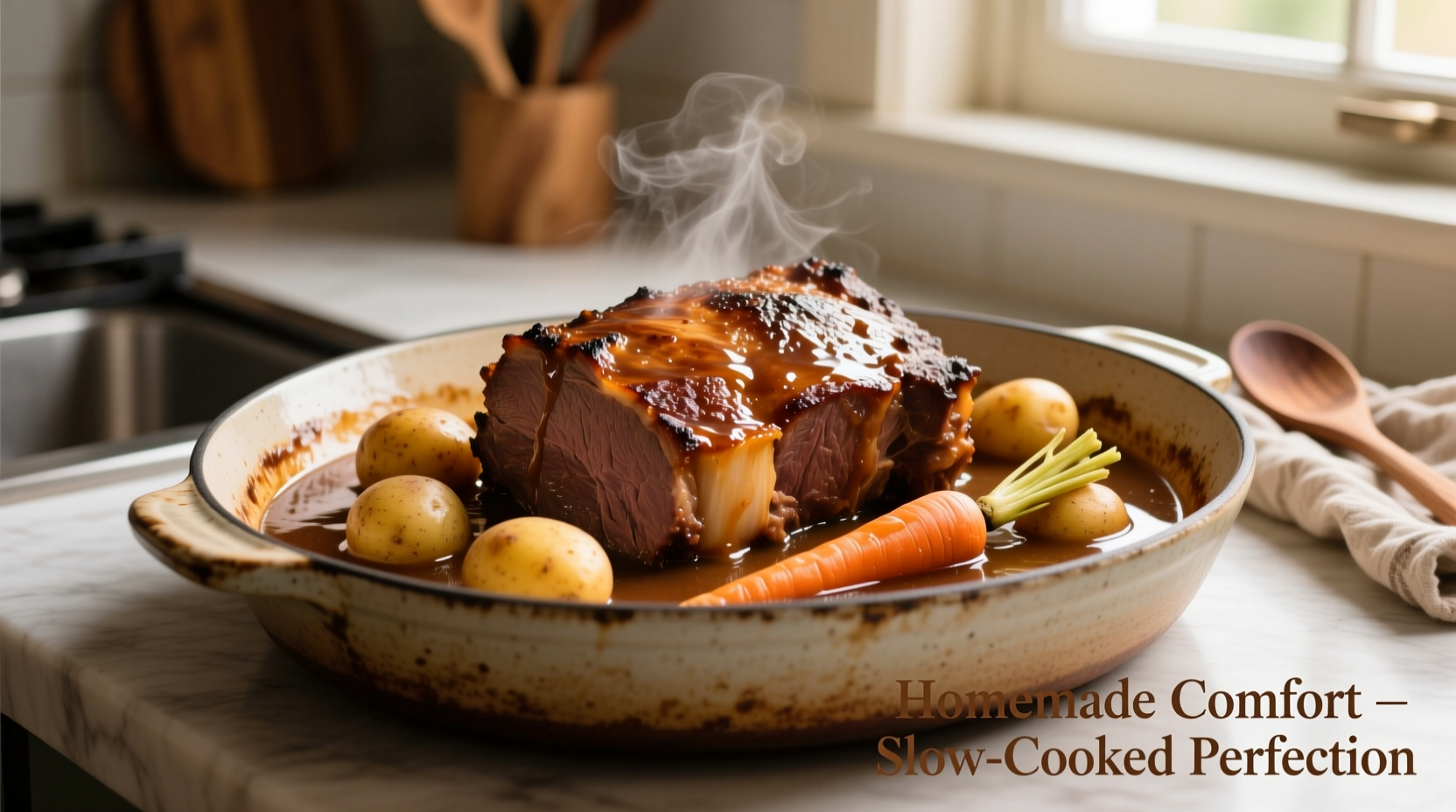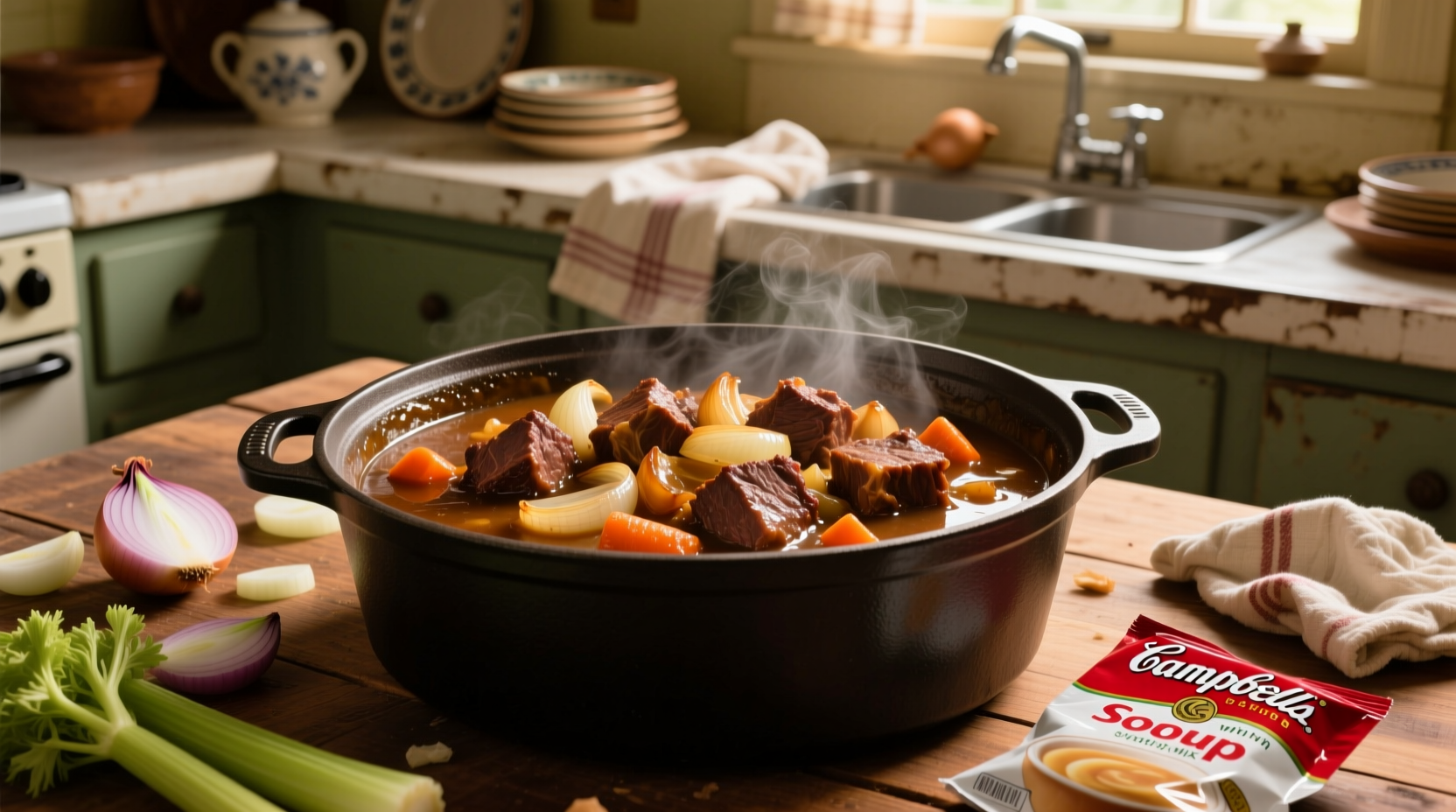Yes, you can make a delicious, tender pot roast using onion soup mix as the primary seasoning. This classic American recipe combines a chuck roast with French onion soup mix, broth, and vegetables for a flavorful, hands-off meal that fills your kitchen with irresistible aromas. The soup mix provides consistent seasoning with minimal effort while creating a rich gravy.
There's something magical about the combination of slow-cooked beef, aromatic vegetables, and that signature onion flavor that makes this pot roast recipe a beloved American classic. As a chef who's cooked in both Michelin-starred restaurants and family kitchens, I've found this onion soup mix method delivers remarkably consistent results with minimal effort—perfect for busy weeknights or impressive enough for Sunday dinners.
Why Onion Soup Mix Works Wonders for Pot Roast
The secret to this recipe's success lies in the French onion soup mix's balanced seasoning profile. Unlike plain onion powder, the mix contains dehydrated onions, beef bouillon, herbs, and just the right amount of salt and sugar that creates a complex flavor base. When combined with liquid during cooking, these ingredients transform into a rich, caramelized gravy that would take hours to develop from scratch.
Professional kitchens often use similar flavor-building techniques, but the soup mix offers home cooks a reliable shortcut. The glutamates in the dehydrated onions and bouillon enhance umami, while the small amount of sugar promotes beautiful browning on the meat's surface—a crucial step for developing deep flavor.

Essential Ingredients and Equipment
For the best results with your pot roast made with onion soup mix, quality ingredients matter. Here's what you'll need:
| Ingredient | Why It Matters | Pro Tip |
|---|---|---|
| 3-4 lb beef chuck roast | Marbling melts during cooking for tender results | Look for "well-marbled" with even fat distribution |
| 1 packet French onion soup mix | Provides consistent seasoning and gravy base | Low-sodium versions work better for control |
| 2 cups beef broth | Creates steam for tenderizing and forms gravy | Use low-sodium to control salt levels |
| 3 tbsp Worcestershire sauce | Boosts umami and balances sweetness | Add during last hour for brightest flavor |
Step-by-Step Cooking Process
Follow these professional-tested steps for perfect pot roast every time:
Preparation (15 minutes)
- Pat the chuck roast completely dry with paper towels—this is critical for proper browning
- Season generously with black pepper (the soup mix provides salt)
- Heat 2 tablespoons of oil in a Dutch oven over medium-high heat until shimmering
- Sear the roast on all sides until deeply browned (about 4 minutes per side)
- Remove roast and set aside while preparing vegetables
Cooking (7-8 hours)
- Add 1 chopped onion, 4 minced garlic cloves, and 2 chopped carrots to the pot
- Cook until softened (about 5 minutes), scraping up browned bits
- Stir in 1 packet onion soup mix and 2 tablespoons tomato paste
- Add 2 cups beef broth and 2 tablespoons Worcestershire sauce
- Return roast to pot, along with 4-5 peeled potatoes and 3 more chopped carrots
- Cover tightly and cook at 300°F (150°C) for 6-7 hours until fork-tender
Food Safety and Temperature Guidelines
Proper cooking temperature ensures both safety and optimal texture. According to the USDA Food Safety and Inspection Service, beef pot roast should reach these internal temperatures:
| Cooking Stage | Minimum Internal Temperature | Source |
|---|---|---|
| Raw beef handling | Keep below 40°F (4°C) | USDA FSIS |
| Cooking temperature | 300°F (150°C) oven | American Institute of Baking |
| Finished roast | 200-205°F (93-96°C) | National Cattlemen's Beef Association |
| Safe holding temperature | Above 140°F (60°C) | USDA Chart |
Troubleshooting Common Issues
Even experienced cooks encounter challenges with pot roast. Here's how to solve the most frequent problems:
- Dry meat: This usually means insufficient cooking time or wrong cut. Chuck roast needs 6-8 hours at low temperature to break down connective tissue properly.
- Weak flavor: Increase browning time on the roast and consider adding 1 tablespoon soy sauce to boost umami without making it taste Asian-inspired.
- Thin gravy: Mix 2 tablespoons cornstarch with 3 tablespoons cold water and stir into the cooking liquid during the last 30 minutes.
- Overcooked vegetables: Add root vegetables during the last 2 hours of cooking to maintain texture.
Historical Context of This Classic Recipe
The pot roast made with onion soup mix emerged during America's mid-20th century convenience food revolution. Here's how this recipe evolved:
| Time Period | Development | Cultural Context |
|---|---|---|
| 1930s-1940s | Traditional pot roast required hours of preparation | Home cooking focused on scratch preparation |
| 1954 | Knorr introduces dehydrated soup mixes | Post-war convenience culture begins |
| 1960s | Onion soup mix becomes popular pot roast seasoning | Rise of "company food" for entertaining |
| 1970s-1980s | Recipe appears in community cookbooks nationwide | Peak of convenience food popularity |
| 2000s-Present | Modern variations with quality ingredients | Return to scratch cooking with convenience shortcuts |
Serving and Storage Recommendations
For the best dining experience, let the pot roast rest for 15-20 minutes before slicing. This allows juices to redistribute throughout the meat. Serve with the cooking liquid strained and thickened slightly for gravy.
Leftovers maintain quality when stored properly:
- Refrigerate within 2 hours of cooking in airtight containers
- Consume within 3-4 days for best quality
- Freeze for up to 3 months in portion-sized containers
- Reheat gently in sauce to maintain moisture
Interestingly, pot roast often tastes even better the next day as flavors continue to meld. The collagen in the meat breaks down further during refrigeration, resulting in exceptionally tender texture when reheated properly.











 浙公网安备
33010002000092号
浙公网安备
33010002000092号 浙B2-20120091-4
浙B2-20120091-4